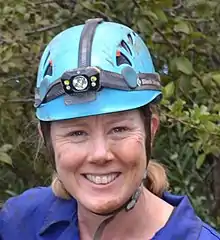Marina Elliott
Marina Elliott is a Canadian biological anthropologist, who is known for being one of the six Underground Astronauts of the Rising Star Expedition.[4]
Marina Elliott | |
|---|---|
 Marina Elliott | |
| Nationality | Canadian |
| Education | |
| Known for | Discovery of Homo naledi[2] |
| Scientific career | |
| Fields | biological anthropology[3] palaeoanthropology[3] |
| Institutions | University of the Witwatersrand |
Eliott has a Master's degree and PhD in biological anthropology from Simon Fraser University in British Columbia, Canada.[1] Elliott has participated in excavations at Lake Baikal in southern Siberia, and at the northernmost archaeological site in the USA: Nuvuk on Point Barrow, Alaska.[5]
While working on her PhD in 2013, Eliott was chosen to be part of a small team of scientists to excavate the Rising Star Cave near Johannesburg, South Africa.[6] Her background in archaeology, caving experience and the ability to squeeze through narrow spaces made Elliott an ideal match for the select team.[6]
She is currently a researcher at the Evolutionary Studies Institute, University of the Witwatersrand, Johannesburg, working on excavations at and around the Rising Star Cave.[1][7] Elliott's research focuses on the archaeology and anatomy of the human skeleton, forensic anthropology and the archaeology of death and burial.[5]
Awards
In 2016, Elliott was awarded the National Geographic Society Emerging Explorer Award. "The program recognizes and supports uniquely gifted and inspiring scientists, conservationists, storytellers and innovators who are making a difference early in their careers."[7]
Selected publications
- Berger, LR; et al. (2017). "Homo naledi and Pleistocene hominin evolution in subequatorial Africa". eLife. 9 (6). doi:10.7554/eLife.24234. PMC 5423770. PMID 28483041.
- Elliott, Marina; et al. (2015). "Estimating body mass from postcranial variales: an evaluation of current equations using a large known-mass sample of modern humans". Archaeological and Anthropological Sciences. 8 (4): 689–704. doi:10.1007/s12520-015-0251-6. S2CID 126828739.
- Elliott, Marina; et al. (2014). "Estimating fossil hominin body mass from cranial variables: an assessment using CT data from modern humans of known body mass". American Journal of Physical Anthropology. 154 (2): 201–214. doi:10.1002/ajpa.22493. PMID 24615366.
- Elliott, Marina; Collard, Mark (2009). "FORDISC and the determination of ancestry from cranial measurements". Biology Letters. 5 (6): 849–852. doi:10.1098/rsbl.2009.0462. PMC 2827999. PMID 19586965.
See also
References
- "Who are the underground astronauts?". EWN. Retrieved 15 December 2017.
- Yong, Ed. "6 Tiny Cavers, 15 Odd Skeletons, and 1 Amazing New Species of Ancient Human". The Atlantic. Retrieved 11 December 2017.
- "Marina Elliott". University of Witwatersrand. Retrieved 11 December 2017.
- Feltman, Rachel. "Meet the six female 'underground astronauts' who recovered our newest relative". Washington Post. Retrieved 11 December 2017.
- "Marina Elliott". TrowelBlazers. Retrieved 11 December 2017.
- "Marina Elliott. Biological Anthropologist". National Geographic. Retrieved 15 December 2017.
- "SFU alumna Marina Elliott named 2016 National Geographic Emerging Explorer". Simon Fraser University. Retrieved 11 December 2017.